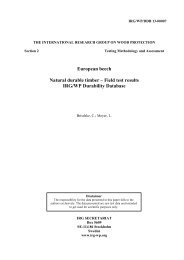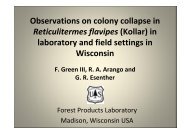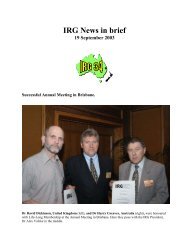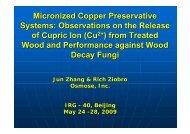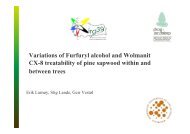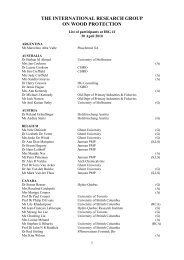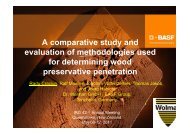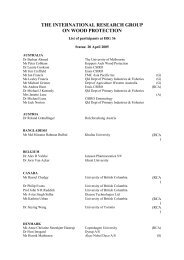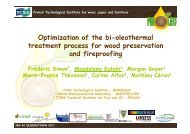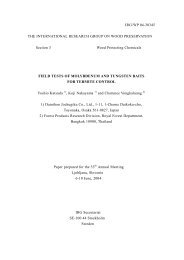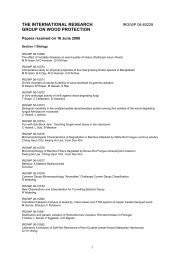(Pinus taeda L.) by proteomic analysis
(Pinus taeda L.) by proteomic analysis
(Pinus taeda L.) by proteomic analysis
You also want an ePaper? Increase the reach of your titles
YUMPU automatically turns print PDFs into web optimized ePapers that Google loves.
Characterization of protein patterns from decayed wood of<br />
loblolly pine (<strong>Pinus</strong> <strong>taeda</strong> L.) <strong>by</strong> <strong>proteomic</strong> <strong>analysis</strong><br />
Young-Min Young Min Kang, Kang,<br />
Lynn Prewitt, and Susan Diehl<br />
Department of Forest Products<br />
Mississippi State University<br />
IRG/WP 08-10654, 08 10654, Tuesday, May 27 th , 2008<br />
The 39th Annual Meeting of IRG in Istanbul, Turkey
Contents<br />
I. Introduction<br />
II. Materials and Methods<br />
III. Results<br />
IV. Conclusion
I. Introduction<br />
Biodeterioration is the undesirable change of<br />
the properties of a material <strong>by</strong> an organism<br />
Wood decay: the loss of billions of US dollars annually<br />
The main fungi of wood decay: Basidiomycete<br />
Traditional methods for protecting wood: chemical preservatives
I. Introduction (continued)<br />
Identification of basidiomycetes and<br />
proteins (enzymes) on wood<br />
What kind of microbes present on wood?<br />
Not all microbes are actively decaying the<br />
wood<br />
When organisms are metabolically active,<br />
such as during wood decay, they produce<br />
proteins
I. Introduction (continued)<br />
� Expressional <strong>proteomic</strong>s can provide a snap shot of all<br />
proteins expressed <strong>by</strong> an organism at the time of extraction.<br />
� During the process of decay, fungi express different<br />
proteins involved in both the decay of wood and metabolism<br />
of the fungus.<br />
� OBJECTIVE of this study is to evaluate protein expression<br />
in decay fungi growing on loblolly pine wood
II. Materials and Methods<br />
Fresh Wood Decayed Wood Inoculated Wood<br />
GT<br />
Gloeophyllum trabeum
II. Materials and Methods (continued)<br />
• IEF and 2DE (Two-dimensional gel electrophoresis)
II. Materials and Methods (continued)<br />
Excise Protein Spots and ID <strong>by</strong> Mass Spec.<br />
Direct Spotting onto<br />
MALDI target<br />
GPS Explorer<br />
Software for Data<br />
Analysis<br />
4800 MALDI TOF/TOF TM<br />
Analyzer<br />
MS/MS Analysis<br />
MS Analysis
III. Results<br />
FW<br />
Fresh Wood = No Proteins Detected
III. Results (continued)<br />
DW<br />
Decayed wood = 1 Protein identified as Actin
III. Results (continued)<br />
IW<br />
Inoculated wood with G. trabeum
III. Results (continued)<br />
Inoculated wood (IW):<br />
� 76 Total proteins detected<br />
� 5 Unidentified (incomplete peptides)<br />
� 54 Hypothetical proteins (unknown proteins)<br />
� 17 Identified<br />
Of those identified: 3 decay enzymes<br />
alcohol oxidase<br />
lipoxygenase<br />
catalase
III. Results (continued)<br />
GT<br />
Pure culture of G. trabeum
III. Results (continued)<br />
From Pure Culture of GT :<br />
� 110 Total proteins detected<br />
� 8 Unidentified (incomplete peptides)<br />
� 57 Hypothetical proteins (unknown proteins)<br />
� 45 Identified<br />
Including actin, heat shock protein, cell division<br />
related enzymes and general metabolic enzymes
IV. Conclusion<br />
This is the first reported <strong>proteomic</strong> <strong>analysis</strong> of<br />
decayed wood and provides a useful tool for<br />
characterization of proteins involved in wood<br />
biodeterioration.<br />
GT on wood needs wood decay enzymes to break<br />
down the wood for food while GT in culture does not<br />
need these enzymes to obtain the food.<br />
This type of comparison will help us understand the<br />
complex mechanism of decay, in particular it will<br />
allow us to discover new proteins not previously<br />
known to play a role in decay.
Conclusion (continued)<br />
This study also highlights one of the current limitations<br />
to fungal <strong>proteomic</strong> studies, the lack of identified fungal<br />
proteins in the available databases.<br />
This problem parallels that which occurred in years<br />
past with the lack of sequence information on GenBank.<br />
We plan to create our own wood decay protein<br />
database.
Conclusion (continued)
ACKNOWLEDGMENTS<br />
Dr. Darrel Nicholas and Dr. Tor Schultz<br />
at Mississippi State University<br />
Dr. Tibor Pechan<br />
(Life Sciences and Biotechnology Institute)<br />
Grant Kirker, Robert Bucci, Lee Mangum, and Min Lee
Questions ?<br />
?



